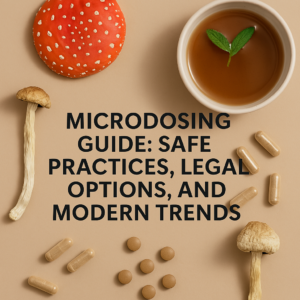Microdosing Psychotropics

In recent years, the practice of microdosing has captured the interest of wellness seekers, creatives, and mental health advocates. This article, Microdosing Guide: Safe Practices, Legal Options, and Modern Trends, explores which substances people microdose, how to approach dosage, and where to legally obtain some of these tools. Because microdosing offers sub-perceptual benefits without full psychedelic effects, it’s become a popular entry point into plant and fungal medicine.
Instead of overwhelming the senses, microdosing supports mood, focus, creativity, and emotional resilience. Many users report enhanced clarity, reduced anxiety, and improved connection to their intuition. While scientific studies continue to grow, anecdotal evidence already points to powerful outcomes when practiced intentionally and safely.
Market Trends
The global microdosing market is growing rapidly. According to a 2024 report by Psychedelic Invest, the legal microdosing supplement market is projected to exceed $2.8 billion by 2030. Products based on Lion’s Mane, Kanna, Amanita Muscaria, and adaptogenic nootropic stacks are leading the charge.
At the same time, public interest in safe psychedelic use continues to rise. Microdosing is being explored for its potential to reduce anxiety, depression, ADHD symptoms, and even post-traumatic stress. From startup founders to therapists and artists, people across generations are embracing these tools.
What Can Be Microdosed?
Unlike recreational use, microdosing uses very small amounts which are typically 1/10th to 1/20th of a standard dose. Because of this, users avoid hallucinations while gaining subtle benefits over time. Below is a breakdown of common substances and how people typically microdose them.
🌿 Commonly Used Substances For Microdosing
Psilocybin Mushrooms (where legal or decriminalized) – boosts mood, promotes neuroplasticity, enhances creativity
LSD (where legal or decriminalized) – sharpens focus, supports mood regulation, and improves cognitive flexibility
Amanita Muscaria (legal in most US states) – reduces anxiety, encourages introspection, and regulates sleep cycles
Lion’s Mane Mushroom (legal) – promotes nerve regeneration, improves memory, and supports long-term brain health
Kanna (legal) – lifts mood, calms anxiety, and supports emotional openness
Salvia Divinorum (restricted or illegal in many areas) – used cautiously for dissociation, visionary insights, and shadow work in micro amounts
Ibogaine (illegal in the U.S., legal in select countries) – supports trauma recovery, addiction interruption, and neurological reset in very small doses
DMT (illegal in most countries) – potentially enhances intuitive insight, dreamwork, and mood regulation in sub-perceptual doses
Emerging Research on Iboga and Ibogaine
Among the most promising developments in psychedelic science is the resurgence of Ibogaine research. Derived from the African Tabernanthe iboga shrub, this compound shows potential in treating PTSD, chemical dependency, and trauma-related neuroplasticity. Although illegal in the United States, research centers in Mexico, New Zealand, and Canada continue to study its microdosing and therapeutic applications.
Studies indicate that even micro amounts of ibogaine may help interrupt addictive thought patterns, stabilize dopamine levels, and promote deep nervous system repair. While not suited for casual use, ibogaine may become a key therapeutic ally in trauma-informed psychiatry.
Dosage Chart for Microdosing

Legal Substances Used For Microdosing
Although some psychedelic substances remain illegal, several powerful allies are fully legal and accessible. While psilocybin and LSD face federal restrictions, adaptogens and legal psychoactives offer a safe entry into microdosing.
For example, Amanita Muscaria, Lion’s Mane, and Kanna are widely available online and can be incorporated into structured wellness routines. When used intentionally and with education, these tools support emotional balance, neurogenesis, and cognitive vitality.
The Legal Status of Salvia Divinorum
Although Salvia Divinorum offers potential in visionary and therapeutic use, it comes with legal complications. As of 2025, 37 states in the U.S. classify it as a controlled substance. In the remaining areas, it may still be sold for incense or ethnobotanical research, but caution is strongly advised.
Unlike other microdosed substances, Salvia’s active compound salvinorin A is highly potent. Even micro amounts can lead to disassociation or out-of-body experiences. While some use tinctures for nervous system resetting or dreamwork, professional guidance is recommended.
Because of its intensity and legality, Salvia should not be used lightly or without integration support.
Frequently Asked Questions
Is microdosing legal?
The legality of microdosing depends on the substance. Most classic psychedelics (like psilocybin, LSD, and DMT) are still federally illegal in the U.S., though some cities and states have decriminalized their use. Substances like Lion’s Mane, kanna, or Amanita muscaria (sometimes used in microdosing)may be legal or unregulated depending on local laws. Always check jurisdiction-specific regulations before engaging in microdosing.
Is microdosing good for anxiety?
Some people find that microdosing helps reduce anxiety by promoting calm, emotional balance, and present-moment awareness. Others may experience the opposite: Increased anxiety or restlessness, especially if the dose is too high or the set/setting isn’t supportive. While early research and anecdotal reports are promising, more clinical studies are needed to understand its role in managing anxiety safely and effectively.
Do you hallucinate while microdosing?
No, microdosing does not produce hallucinations when done properly. The goal is to stay well below the threshold of perceptual effects. If visual distortions, euphoria, or sensory changes occur, the dose is likely too high and enters a mini-dose or low-dose range instead of a true microdose.
What are the benefits of microdosing?
Reported benefits of microdosing include:
Enhanced mood and emotional resilience
Sharper focus and mental clarity
Boosted creativity and flow states
Greater self-awareness and introspection
Support with breaking habits or shifting perspectives
While many find it helpful for depression, anxiety, ADHD, or burnout, experiences vary widely. Integration practices like journaling, breathwork, or coaching can help deepen the benefits over time.
Final Note
Throughout this Microdosing Guide: Safe Practices, Legal Options, and Modern Trends, you’ve seen how small doses can create big shifts. Whether you choose mushrooms, botanicals, or fungi like Amanita, the key lies in ritual, intention, and education.
Because microdosing invites transformation, treat it with reverence and structure. Start slowly, track your experiences, and prioritize integration.
*Juana Wellness is an affiliate*

One Response